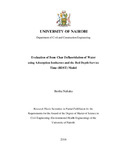| dc.description.abstract | Sustained intake of elevated fluoride concentrations cause dental or skeletal
fluorosis, a chronic disease manifested by mottling of teeth in mild cases and
softening of bones and neurological damage in severe cases. Excessive and
undesirable levels of fluoride in drinking water supplies are a major problem
in the Rift Valley of Kenya. Fluoride concentrations range from 5 to 15 mg/L
as compared to the WHO maximum permissible levels of 1.5 mg/L in drinking
water. Current methods of fluoride removal from water include adsorption
onto activated alumina, bone char and clay, precipitation with lime, dolomite
and aluminum sulphate, ion exchange, and membrane processes such as
reverse osmosis, electrodialysis and nano filtration. Most of these methods are
expensive and technically non-feasible for rural communities in Kenya. This
study evaluated the efficacy of locally available bone char in removal of
fluoride from water. The bone char reduced fluoride concentration from 8.1
mg/L to within WASREB threshold of 3 mg/L for exceptionally high
concentration of fluoride in 50 minutes and to within the WHO limit
concentration of 1.5 mg/L in 2 hours. Fluoride removal was analyzed using
adsorption isotherms; namely, Freundlich and Langmuir isotherms.
Adsorption of fluoride on to bone char conforms to Freundlich Isotherm but
not to Langmuir Isotherm indicating that the bone char media is not a
homogenous media. Freundlich adsorbate capacity, Kf, increased with media
size from 3.95 x 10-3 to 1.75 x 10-2 (L/g) for fine and medium size media,
respectively, but adsorption intensity, 1/n, decreased from 1.657 to 1.043,
which may explain the lack of significant difference between the fine and
medium size media. To predict the fluoride breakthrough in a bone char fixedbed
system, fluoride removal was modeled using the bed depth service time
(BDST) model with bed capacity, No, of 79, 411 and 1269 mg/cm3 and
adsorption rate constant, K, of0.139, 0.017 and 0.005 (cm3/mg-hr) for 80, 60
and 40 ml/L flowrates respectively. The study recommended further work on
optimization of the continuous process with other adsorption configurations
such as up flow fixed and moving bed. | en_US |



